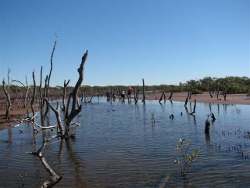|
|
Mangrove diebackMangrove communities can experience dieback from natural and human-related causes. Mangrove dieback can have many causes such as weather, insects and disease, nutrients, pollution, climate change, rapid siltation and changes to sea level and tides. Quick facts
Causes of diebackWeatherEpisodic climatic events such as heavy rainfall and prolonged flooding drown mangroves and cause extensive dieback. In 1974, the Brisbane River lost most of its mangrove community due to prolonged flooding from a severe rain depression after a cyclone. A severe hail storm in 1999 damaged a large area of mangroves in Moreton Bay. Changes in rainfall patterns due to drought affect the relative extent of mangrove and saltmarsh communities. Rainfall patterns might also cause sinking of sediments due to reduction in groundwater levels, oxidation of acid sulphate soils which underlie most mangrove areas, and collapse of soil profile. Insects and diseaseHeavy infestations of insects may defoliate mangroves and give the appearance of dieback. Fungal diseases can kill mangroves as happened to a community of river mangroves (Aegiceras) under the South-East Freeway in Brisbane during the summer of 2006. In the late 1970s, a soil fungus, Phytoplankton cinnamomi, caused large areas of dieback around Gladstone, central Queensland. NutrientsExcess nutrients can led to a build-up of algal bunds on mangrove roots which cause water to pond and leads to drowning e.g. at the mouth of the Brisbane River. PollutionMangroves can also be affected by pollutants causing stress as photosynthesis may be affected or genetic defects and a greater susceptibility to disease. Oil can kill mangroves, lenticels covered in oil can no longer draw in air and the plant can suffocate. Climate changeProjected sea level rise due to climate change will add to the pressure on remaining mangrove communities as these may not be able to move inland due to barriers from foreshore developments, sea walls, revetments and other infrastructure on the coast. Rapid siltationSiltation covering the pneumatophores of mangrove can cause dieback e.g. 2011 when the Brisbane River lost high proportion of its mangrove community due to siltation from flooding covered the pneumatophores of grey mangrove[1] Sea level and tidesMangrove dieback in the Gulf of Carpentaria in late 2015 early 2016 was likely associated with climatic water balance deficit that was further impacted by the fact that the highest tides reached record low high tide levels due to sea level drop[1]. Additional informationReferences
Last updated: 14 November 2019 This page should be cited as: Department of Environment, Science and Innovation, Queensland (2019) Mangrove dieback , WetlandInfo website, accessed 8 May 2025. Available at: https://wetlandinfo.des.qld.gov.au/wetlands/ecology/components/biota/flora/flora-structural/mangroves/mangrove-dieback.html |

 — Department of the Environment, Tourism, Science and Innovation
— Department of the Environment, Tourism, Science and Innovation


